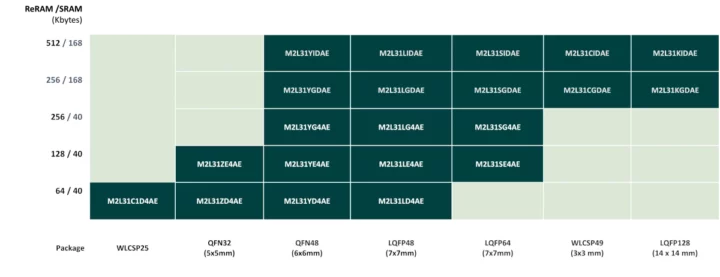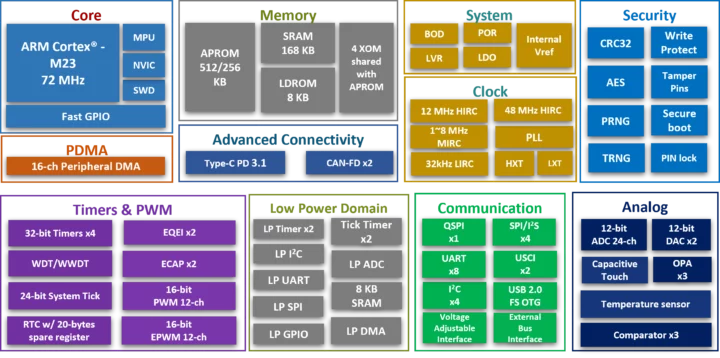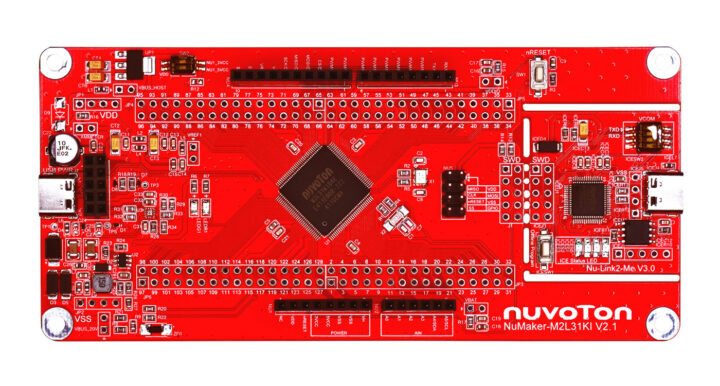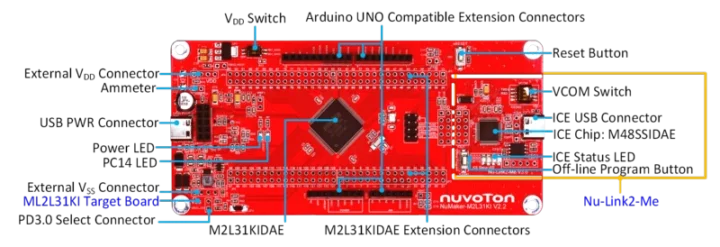Nuvoton NuMicro M2L31 is a family of Arm Cortex-M23 microcontrollers clocked up to 72 MHz, equipped with 64KB to 512KB high-durability ReRAM (Resistive Random-Access Memory) with fast write speeds, 40KB to 168KB SRAM. The microcontroller supports 1.71V to 3.6V operating voltage, can operate in the -40°C to 105°C temperature range, and offers a wide range of interfaces available through packages as small as WLCSP 25 (2.5 x 2.5 mm) and up to LQFP128 (14 x 14 mm).
Arm introduced the Cortex-M23 core in 2016 together with the Arm Cortex-M33 core, but while the latter is widely integrated in a large range of designs, we’ve seen fewer Cortex-M23 microcontrollers with some examples being Microchip SAML10/L11 (2018) and more recently, the Renesas RA0 family. Nuvoton adds another option with the Numicro M2L31 that also happens to integrates ReRAM non-volatile memory.
Key Features:
- MCU core – Arm Cortex-M23 core running up to 72 MHz
- Memory
- 64KB, 128KB, 256KB, 512KB Resistive RAM (ReRAM) embedded without the need for an erase cycle to save read and write time; support for byte read/write operations
- Up to 168 KB SRAM with 40KB parity check
- Independent 4/8 KB Low Power SRAM
- 8 KB LDROM
- 4x eXecute-Only-Memory (XOM) regions
- 4x Memory Protection Unit (MPU) memory regions
- Peripheral/Communication interfaces
- USB
- USB 2.0 full-speed OTG/Host/Device controller with maximum 1024 bytes’ buffer size
- Compliant with Type-C (Rev.2.1) and Power Delivery (Rev. 3.0) specification
- Up to 8x UART interfaces include LIN and IrDA
- 1x Low Power UART interface
- Up to 2x USCI interface (UART / SPI / I²C)
- Up to 4x I2C interfaces
- 1x Low Power I2C interface (400 kbps)
- Up to 4x SPI/I2S interfaces (up to 36 MHz)
- 1x Low Power SPI interface (up to 12 MHz)
- 1x Quad Serial Peripheral Interface (QSPI)
- Up to 1x External Bus Interface (EBI)
- Up to 2x sets of CAN FD controllers
- Up to 16x touch keys with single-scan or programmable periodic key scans with 5V tolerance
- USB
- Analog
- Built-in internal reference voltage
- Built-in temperature sensor
- 1x 12-bit SAR ADC up to 24-ch 3.42 MSPS
- Up to 2x DAC (12-bit, 1 MSPS with buffer)
- 3x rail-to-rail comparators with 6-bit DAC function
- Up to 3x sets of OP Amplifiers
- Control Interfaces
- Voltage Adjustable Interface (VAI)
- Up to 2x Enhanced Quadrature Encoder Interfaces (EQEI)
- Up to 2x input Enhanced Input Capture timers (ECAP)
- PDMA – Up to 16 channels of Peripheral DMA Controller
- Security
- Cyclic Redundancy Calculation Unit
- AES encryption with 128/192/256-bit key
- True random number generator (TRNG)
- Pseudo-random number generator (PRNG)
- Up to 3x Tamper pins
- Timers
- 32x PWM output channels
- 4x 24-bit timers, supporting up to 1 independent PWM output
- 12x Enhanced PWM (EPWM) with twelve 16-bit counters, up to 72 MHz for timer clock source
- 12x PWM with six 16-bit timers, up to 144 MHz for timer clock source
- 2x 24-bit Low Power Timers
- 2x Tick Timers
- 1x 24-bit count-down SysTick timer
- Watchdog timer
- Window watchdog timer
- Clocks
- 4 to 32 MHz crystal oscillator
- 32.768 kHz crystal oscillator for RTC
- Internal 12 MHz RC oscillator with ± 2% deviation at -40~105°C
- Internal 48 MHz RC oscillator with ±2.5% deviation at -40~105°C
- Internal 1~8 MHz MIRC with ±10% deviation at -40~105°C
- Internal 32 kHz RC oscillator with ±10% deviation
- Internal PLL up to 144 MHz
- Voltage range – 1.71V to 3.6V
- Power Consumption
- Normal run: 60 μA/MHz at 72 MHz
- Idle mode: 33μA/MHz at 25°C/3.0V, all peripherals disabled condition
- NPD w/o power gating (NPD2 mode): 55 uA, at 25°C/3.0V
- NPD w/ power gating (NPD4 mode): 9 uA, at 25°C/3.0V
- SPD w/ 40KB SRAM retention: 1.7 uA, at 25°C/3.0V
- DPD: 0.54uA at 25°C/3.0V, RTC and LXT disabled
- Packages
- WLCSP 25 (2.5 x 2.5 mm)
- QFN32 (5 x 5 mm)
- LQFP48 (7 x 7 mm)
- QFN 48 (5 x 5 mm)
- WLCSP 49 (3.0 x 3.0 mm)
- LQFP64 (7 x 7 mm)
- LQFP128 (14 x 14 mm)
- Temperature Range – -40°C to +105°C
 Twenty one different SKUs are available with seven different packages and various ReRAM and SRAM capacities. Nuvoton explains that ReRAM (Resistive Random-Access Memory) is a type of non-volatile memory that achieves digital data storage by altering the resistance state of its components through the application of an external voltage. It benefits from fast read/write speeds, low power consumption, and higher durability. One reason for the fast write speed is that ReRAM does not require a page erase operation before writing contrary to traditional embedded flash memories. It also supports single-byte read/write operations. The Nuvoton M2L31 is the first MCU with ReRAM that we’ve ever covered on CNX Software, but sadly, I was unable to find any metrics related to the speed and durability of ReRAM in either the datasheet or technical reference manual of the microcontroller.
Twenty one different SKUs are available with seven different packages and various ReRAM and SRAM capacities. Nuvoton explains that ReRAM (Resistive Random-Access Memory) is a type of non-volatile memory that achieves digital data storage by altering the resistance state of its components through the application of an external voltage. It benefits from fast read/write speeds, low power consumption, and higher durability. One reason for the fast write speed is that ReRAM does not require a page erase operation before writing contrary to traditional embedded flash memories. It also supports single-byte read/write operations. The Nuvoton M2L31 is the first MCU with ReRAM that we’ve ever covered on CNX Software, but sadly, I was unable to find any metrics related to the speed and durability of ReRAM in either the datasheet or technical reference manual of the microcontroller.
The NuMicro M2L31 series microcontrollers are supported by third-party IDEs such as Keil MDK and IAR EWARM, as well as the NuEclipse IDE with GNU GCC compiler. The company also provides the NuMaker-M2L31KI for evaluation.
NuMaker-M2L31KI highlights:
- MCU – M2L31KIDAE Cortex-M23 microcontroller with 168KB SRAM, 512KB ReRAM
- Expansion
- Arduino UNO compatible extension connectors
- 4x 32-pin expansion headers for access to all I/Os
- Debugging – Nu-Link2-Me SWD debugger with USB-C port, Virtual COM switch, status LED, On-line /off-line programming
- Misc
- Ammeter connector for measuring the microcontroller’s power consumption
- Power supply
- External VDD power connector
- Arduino UNO compatible extension connector Vin
- USB power connector on the M2L31 platform
- ICE USB connector on Nu-Link2-Me
Target applications for the NuMicro M2L31 Cortex-M23 microcontrollers include motor control, PC peripherals, industrial automation solutions, and battery management systems. The product page has more information including links to documentation such as TRM and datasheet as well as software development resources.
I was unable to find pricing for the M2L31 microcontrollers, but the NuMaker-M2L31KI development board can be purchased for $36 on Nuvoton Direct.

Jean-Luc started CNX Software in 2010 as a part-time endeavor, before quitting his job as a software engineering manager, and starting to write daily news, and reviews full time later in 2011.
Support CNX Software! Donate via cryptocurrencies, become a Patron on Patreon, or purchase goods on Amazon or Aliexpress









Some extra information about the ReRAM read/write speeds and endurance.